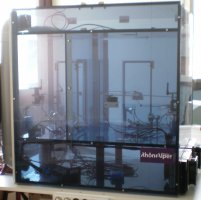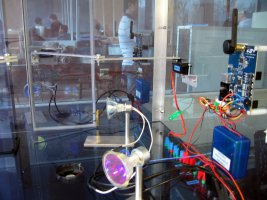Niveau d'étude
Bac +5
ECTS
3 crédits
Composante
UFR PhITEM (physique, ingénierie, terre, environnement, mécanique)
Période de l'année
Automne (sept. à dec./janv.)
Description
This five months project (in parallel with the theoretical classes) investigates new automation solutions for real-time feedback operation, the minimization of energy consumption in key industrial processes and the analysis and optimization of complex dynamical systems. This automation is based on distributed sensing capabilities, networked sensors, physical modeling for the process automation design and real-time feedback control. The design project is structured into two parts: from September to December with meetings every other week in Design Project 1, and in January with meetings multiple times per week in Design Project 2.
Objectifs
Different projects are proposed to small groups of students (from 2 to 4), for example on:
- zone mapping and path optimization with communicating robots;
- heat pump automation for energy savings;
- under floor air distribution (UFAD) for intelligent buildings;
- water distribution design for green building automation;
- robot design and stabilization with embedded control algorithms.
- analyze the project objectives and description of work to determine the research schedule, including specific milestones with the key technical issues and the titles and overview of deliverables;
- perform an exhaustive bibliographical research to clearly state the actual available technology and propose some innovative improvements;
- propose different models of the plants, stressing out the key points and necessary assumptions, along with the design of a real-time simulator;
- define the control problem, in terms of objectives, costs and constraints, and compare different control approaches;
- provide a detailed technical solution for building an experimental facility that illustrates the main real-time closed-loop control issues.


Example of a long term project: the UFAD experiment. The air is cooled in the lower plenum by Peltier modules and then injected in each room thanks to fans, regulated from temperature measurements by Zigbee modules. Disturbances are generated by the light bulbs (heating effect) and opening/closing of doors. The heated air naturally flows into the upper plenum, where it is driven back in the underfloor.
The UFAD project has been carried over more than five years with several topics that illustrate the different curriculum objectives:
- intelligent buildings and the use of under-floor cool air injection, in which the students analyzed the available industrial solutions and potential interest of this application (thus setting the general project goals);
- controlled air momentum in stratified flows, focused on the study of the impact of floor diffusers and generated temperature gradients within a room;
- 0-D modeling and automation of an experimental benchmark, to determine the size and specificity of the experiment depicted in the Figure;
- local vs. MIMO control of the rooms temperature, to compare the use of local PID loops in each room with a robust MIMO controller, on the simulator;
- data acquisition and embedded control with the Zigbee motes, mainly focused on real-time programming and protocols.
Heures d'enseignement
- TPTP23h
Période
Semestre 9

